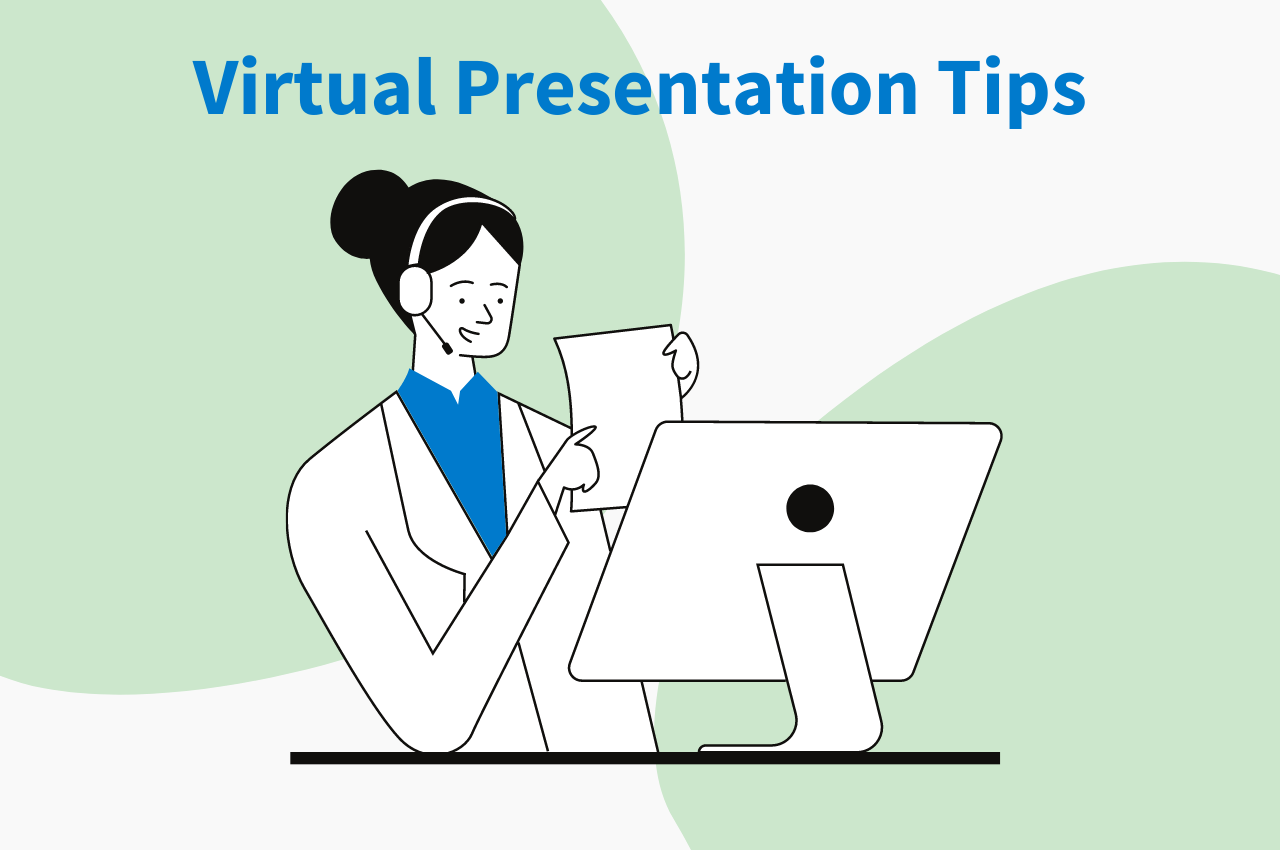Virtual presentations tips that work: be a rockstar from afar

Remote meetings and presentations are here to stay – in 2018, 40% of global companies were hybrid and 16% were fully remote. With the entire world adjusting to full remote life due to the COVID-19 pandemic, those numbers are expected to skyrocket. This means it is time to adapt our presentation styles and how we prepare ourselves for virtual presentations. From handheld microphones, podiums, and laser pointers, we evolve to laptop webcams, virtual backgrounds, and the microphones attached to our earbuds. If you’re preparing a virtual presentation, here are a few tips and tricks to becoming a professional virtual presenter.
What to prepare before the presentation
Check your tech
The most important thing to do before a presentation is check your technology. Is your wifi working? Did you update your videoconferencing software? Is your microphone plugged in? Checking these small details are critical because any of these issues could disrupt your presentation and distract the audience. We also recommend doing some research into different videoconferencing software and choosing one that works best for your style of presentation and audience size.
Create a professional and clean appearance
Don’t worry, you don’t need to put your sweatpants away. A professional appearance on camera (note: your sweatpants won’t be seen) will reduce distractions and create a comfortable viewing experience for your remote audience. Three key factors to consider when creating a professional appearance are:
- Background
- Lighting
- Your clothes
Many of us have set up home offices in our dining rooms, basements, and anywhere we can find quiet time and that is okay. However, for a virtual presentation, you might want to set up in a cleaner setting. It is best to present in front of a blank wall or use a virtual background. Having a chaotic background may distract your audience from your presentation as they focus on what is going on behind you.
In addition to a blank wall, make sure you are in a well-lit space, preferably facing a window or with a lamp in front of your face. You never want to face a window as you will show up as a shadowy silhouette. If you can’t move your position, close the window and turn up the brightness on your computer so that it can shine a bit of light on your face.
Back to those sweatpants – you can keep them on, but do dress nicely up top. Full business professional is not necessary, but try to stick to neutral colors with minimal patterns. Plaid or stripes can create odd illusions on camera and high contrast colors like all black or white may wash you out. Soft beige, blue, or gray are great color options. Check out our Pinterest for fashion tips for presenters.
During the presentation
Your mind may be rushing to get this presentation over with but you must pace yourself and show some personality. A good presenter is active, energetic, and charismatic. Bring your full self to your presentation and make sure to make eye contact with your audience by looking directly at the camera and not your screen. Think of this presentation as your debut as a YouTuber or a news anchor. Your audience will appreciate the energy.
Neat slides go a long way
We all know the golden rule of slide decks – the less words the better. This rule was meant to make slides visible even from the back of a conference room. If everyone is viewing from their own computers in a virtual presentation, this means we can cram as many words as possible right? Absolutely not. The audience is there to listen to you, not read your notes. Here are some additional tips to having a neat slide deck:
- Use descriptive titles so the audience understands the slide without having to see all of it
- Replace chunks of text with graphs or images
- Avoid fancy transitions that may act finicky on different screens
Engage the audience
Most of your audience is multi-tasking, 65% to be exact. Especially during a virtual presentation, your audience’s attention span may be wavering. The best way to maintain their attention is to interact in 10 minute intervals. Ask your audience for their opinion about a specific part of your presentation with an open-ended response activity or do a fun word cloud asking them to summarize what you’ve presented so far. These questions are quick and will get your audience’s minds working again.
To reduce disrupting the flow of the presentation, use audience engagement tools that can be integrated into your slides. To seamlessly add interactive polls to your slides without having to open a browser, consider downloading the Poll Everywhere for PowerPoint app for Windows or iOS.
After the presentation
Most presentations, virtual or in-person, will end with a live Q&A with the speaker. Q&A’s are great for clarifying any questions or concerns the audience may have. Use a Q&A activity to allow the audience to submit questions and upvote or downvote other attendees questions. You also have the option of setting a Pinned Q&A activity to run in the background and collect questions along the way. Pinned Q&A’s are best because audience members can submit questions as they think of them instead of forgetting them by the end of the presentation.
A great way to follow-up on your presentation is to send a survey. Send a post-presentation survey to gather honest feedback on your presentation skills, which will help you become a better presenter in the future. Click here to copy a premade survey directly to your Poll Everywhere account.
In today’s fast paced world, adapting to situations and relearning our skills is vital to keeping up. We hope these tips help you become a rockstar virtual presenter in today’s era of remote meetings and conferences. If you don’t already have one, consider creating a Poll Everywhere account today and start engaging your virtual audience.